Theoretical Paper
- Computer Organization
- Data Structure
- Digital Electronics
- Object Oriented Programming
- Discrete Mathematics
- Graph Theory
- Operating Systems
- Software Engineering
- Computer Graphics
- Database Management System
- Operation Research
- Computer Networking
- Image Processing
- Internet Technologies
- Micro Processor
- E-Commerce & ERP
Practical Paper
Industrial Training
Scheduling and its types
The process scheduling is the activity of the process manager that handles the removal of the running process from the CPU and the selection of another process on the basis of a particular strategy.
Process scheduling is an essential part of a Multiprogramming operating system. Such operating systems allow more than one process to be loaded into the executable memory at a time and loaded process shares the CPU using time multiplexing.
Scheduling Queues
Scheduling queues refers to queues of processes or devices. When the process enters into the system, then this process is put into a job queue. This queue consists of all processes in the system. The operating system also maintains other queues such as device queue. Device queue is a queue for which multiple processes are waiting for a particular I/O device. Each device has its own device queue.
This figure shows the queuing diagram of process scheduling.
Queue is represented by rectangular box.
The circles represent the resources that serve the queues.
The arrows indicate the process flow in the system.
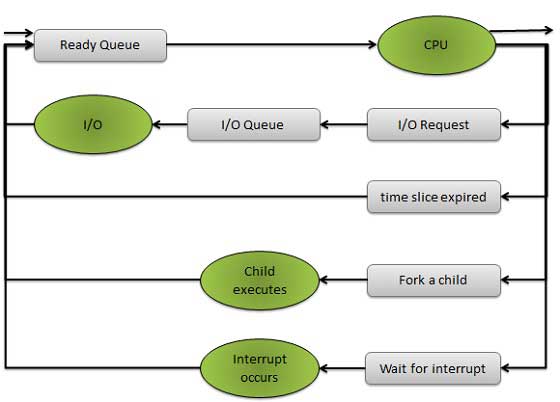
Queues are of two types
Ready queue
Device queue
A newly arrived process is put in the ready queue. Processes waits in ready queue for allocating the CPU. Once the CPU is assigned to a process, then that process will execute. While executing the process, any one of the following events can occur.
The process could issue an I/O request and then it would be placed in an I/O queue.
The process could create new sub process and will wait for its termination.
The process could be removed forcibly from the CPU, as a result of interrupt and put back in the ready queue.
Two State Process Model
Two state process model refers to running and non-running states which are described below.
| S.N. | State & Description |
|---|---|
| 1 | Running When new process is created by Operating System that process enters into the system as in the running state. |
| 2 | Not Running Processes that are not running are kept in queue, waiting for their turn to execute. Each entry in the queue is a pointer to a particular process. Queue is implemented by using linked list. Use of dispatcher is as follows. When a process is interrupted, that process is transferred in the waiting queue. If the process has completed or aborted, the process is discarded. In either case, the dispatcher then selects a process from the queue to execute. |
Schedulers
Schedulers are special system softwares which handles process scheduling in various ways.Their main task is to select the jobs to be submitted into the system and to decide which process to run. Schedulers are of three types
Long Term Scheduler
Short Term Scheduler
Medium Term Scheduler
Long Term Scheduler
It is also called job scheduler. Long term scheduler determines which programs are admitted to the system for processing. Job scheduler selects processes from the queue and loads them into memory for execution. Process loads into the memory for CPU scheduling. The primary objective of the job scheduler is to provide a balanced mix of jobs, such as I/O bound and processor bound. It also controls the degree of multiprogramming. If the degree of multiprogramming is stable, then the average rate of process creation must be equal to the average departure rate of processes leaving the system.
On some systems, the long term scheduler may not be available or minimal. Time-sharing operating systems have no long term scheduler. When process changes the state from new to ready, then there is use of long term scheduler.
Short Term Scheduler
It is also called CPU scheduler. Main objective is increasing system performance in accordance with the chosen set of criteria. It is the change of ready state to running state of the process. CPU scheduler selects process among the processes that are ready to execute and allocates CPU to one of them.
Short term scheduler also known as dispatcher, execute most frequently and makes the fine grained decision of which process to execute next. Short term scheduler is faster than long term scheduler.
Medium Term Scheduler
Medium term scheduling is part of the swapping. It removes the processes from the memory. It reduces the degree of multiprogramming. The medium term scheduler is in-charge of handling the swapped out-processes.

Running process may become suspended if it makes an I/O request. Suspended processes cannot make any progress towards completion. In this condition, to remove the process from memory and make space for other process, the suspended process is moved to the secondary storage. This process is called swapping, and the process is said to be swapped out or rolled out. Swapping may be necessary to improve the process mix.
Comparison between Scheduler
| S.N. | Long Term Scheduler | Short Term Scheduler | Medium Term Scheduler |
|---|---|---|---|
| 1 | It is a job scheduler | It is a CPU scheduler | It is a process swapping scheduler. |
| 2 | Speed is lesser than short term scheduler | Speed is fastest among other two | Speed is in between both short and long term scheduler. |
| 3 | It controls the degree of multiprogramming | It provides lesser control over degree of multiprogramming | It reduces the degree of multiprogramming. |
| 4 | It is almost absent or minimal in time sharing system | It is also minimal in time sharing system | It is a part of Time sharing systems. |
| 5 | It selects processes from pool and loads them into memory for execution | It selects those processes which are ready to execute | It can re-introduce the process into memory and execution can be continued. |
Context Switch
A context switch is the mechanism to store and restore the state or context of a CPU in Process Control block so that a process execution can be resumed from the same point at a later time. Using this technique a context switcher enables multiple processes to share a single CPU. Context switching is an essential part of a multitasking operating system features.
When the scheduler switches the CPU from executing one process to execute another, the context switcher saves the content of all processor registers for the process being removed from the CPU, in its process descriptor. The context of a process is represented in the process control block of a process.
Context switch time is pure overhead. Context switching can significantly affect performance as modern computers have a lot of general and status registers to be saved. Content switching times are highly dependent on hardware support. Context switch requires ( n + m ) bxK time units to save the state of the processor with n general registers, assuming b are the store operations are required to save n and m registers of two process control blocks and each store instruction requires K time units.
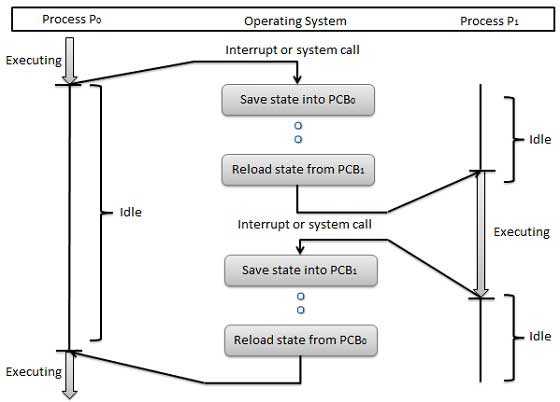
Some hardware systems employ two or more sets of processor registers to reduce the amount of context switching time. When the process is switched, the following information is stored.
Program Counter
Scheduling Information
Base and limit register value
Currently used register
Changed State
I/O State
Accounting
We'll discuss four major scheduling algorithms here which are following
First Come First Serve (FCFS) Scheduling
Shortest-Job-First (SJF) Scheduling
Priority Scheduling
Round Robin(RR) Scheduling
Multilevel Queue Scheduling
First Come First Serve (FCFS)
Jobs are executed on first come, first serve basis.
Easy to understand and implement.
Poor in performance as average wait time is high.
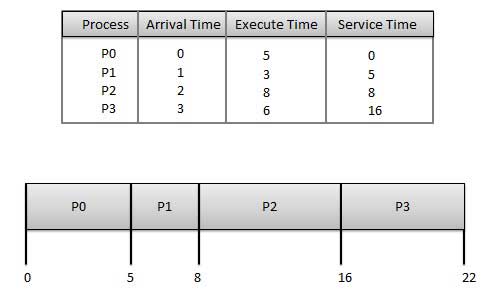
Wait time of each process is following
| Process | Wait Time : Service Time - Arrival Time |
|---|---|
| P0 | 0 - 0 = 0 |
| P1 | 5 - 1 = 4 |
| P2 | 8 - 2 = 6 |
| P3 | 16 - 3 = 13 |
Average Wait Time: (0+4+6+13) / 4 = 5.55
Shortest Job First (SJF)
Best approach to minimize waiting time.
Impossible to implement
Processer should know in advance how much time process will take.
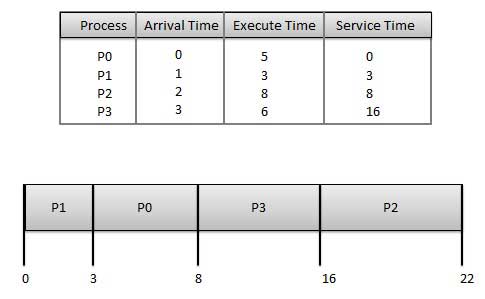
Wait time of each process is following
| Process | Wait Time : Service Time - Arrival Time |
|---|---|
| P0 | 3 - 0 = 3 |
| P1 | 0 - 0 = 0 |
| P2 | 16 - 2 = 14 |
| P3 | 8 - 3 = 5 |
Average Wait Time: (3+0+14+5) / 4 = 5.50
Priority Based Scheduling
Each process is assigned a priority. Process with highest priority is to be executed first and so on.
Processes with same priority are executed on first come first serve basis.
Priority can be decided based on memory requirements, time requirements or any other resource requirement.
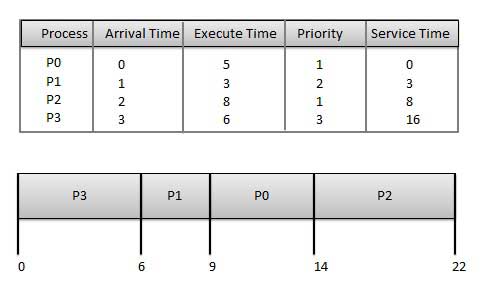
Wait time of each process is following
| Process | Wait Time : Service Time - Arrival Time |
|---|---|
| P0 | 9 - 0 = 9 |
| P1 | 6 - 1 = 5 |
| P2 | 14 - 2 = 12 |
| P3 | 0 - 0 = 0 |
Average Wait Time: (9+5+12+0) / 4 = 6.5
Round Robin Scheduling
Each process is provided a fix time to execute called quantum.
Once a process is executed for given time period. Process is preempted and other process executes for given time period.
Context switching is used to save states of preempted processes.
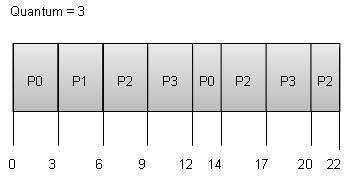
Wait time of each process is following
| Process | Wait Time : Service Time - Arrival Time |
|---|---|
| P0 | (0-0) + (12-3) = 9 |
| P1 | (3-1) = 2 |
| P2 | (6-2) + (14-9) + (20-17) = 12 |
| P3 | (9-3) + (17-12) = 11 |
Average Wait Time: (9+2+12+11) / 4 = 8.5
Multi Queue Scheduling
Multiple queues are maintained for processes.
Each queue can have its own scheduling algorithms.
Priorities are assigned to each queue.

